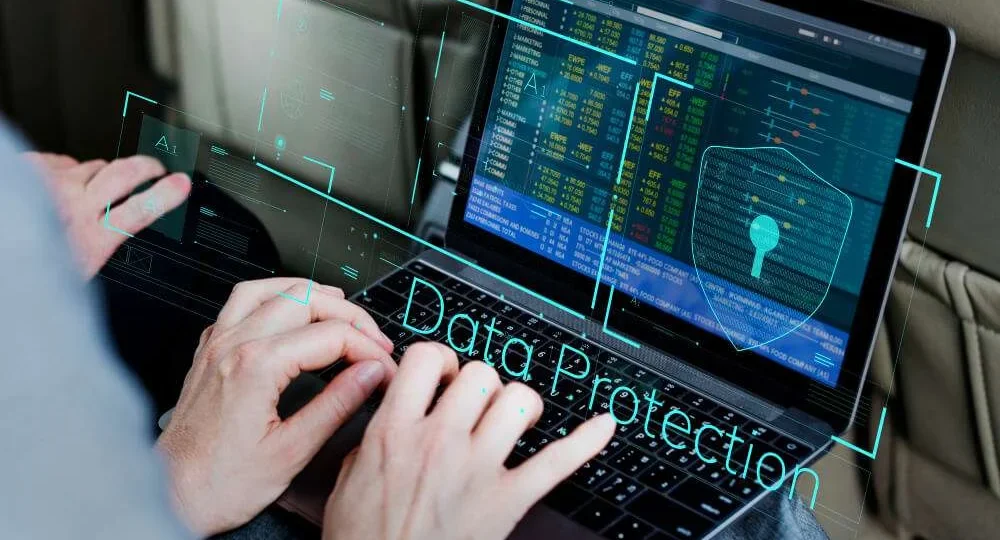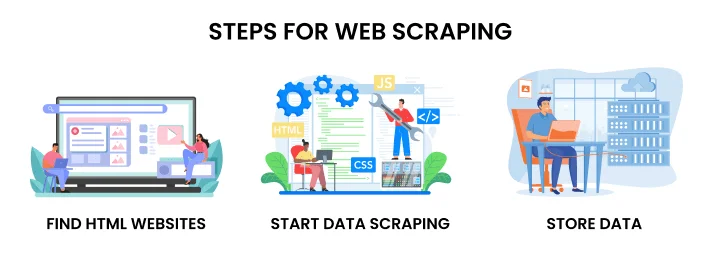
Table of Contents
What Is Web Data Scraping?
Web data scraping is the process of extracting information from websites using particular software with the skill and expertise of a developer. Consider it an online meeting place for facts and figures intended to analyze trends, research, or optimize the methods of gathering data. Techniques that were earlier used for extracting information from the web placed stress on the copying and pasting of text.
However, as the internet extended and the necessity for data grew, new tools and procedures to apply these tasks mechanically developed. Today, it is impossible to enumerate the sphere where web scraping plays a key role and becomes the basis of many decisions.
If you are capable of scraping web data, then well and good, but if you are a non-techy person or business owner, then you may face challenges. But today, many expert developers and a few companies provide web scraping services on a job basis and scrape data for you, so you don’t need to worry about it. Simply inform him of your business industry, and they will collect data for you.
While web crawling is based on viewing the web pages systematically (like in the case of Google, which compiles data for the Internet search engine), data mining deals with large datasets and searches for patterns in them. Web scraping is located in between these two, focusing on the direct extraction of data from particular websites.
Why Do We Scrape Data?
Thus, what is there to gain when people scrape data? The reasons span a wide spectrum: The reasons span a wide spectrum:
- Collecting Market Insights: In this case, the information collected includes business trends, consumers’ preferences, and competitors’ plans.
- Academic Research: Web users may collect information to conduct polls or examine the tendency of people’s behavior on the Internet.
- Content Aggregation: Scraping is used by websites that source a particular set of information from several websites.
If we compare the manual data collection to the automated scraping, we can easily understand the difference as to how effective the scraping is as compared to the manual endeavor. Manual approaches can be described as tiresome, time-consuming, and often include human mistakes. However, automated scraping can easily obtain a plentiful amount of data and is also less likely to be imprecise.
Some of the industries that currently rely on web scraping are e-commerce (for comparing prices), finance (for tracking stock), and journalism (for pulling news articles).
Ethical and legal considerations
It is essential to be cautious when considering web scraping because it is governed by unknown laws. As you scrape, it is not a criminal act, but it collides with copyright, terms of service, and privacy laws. Almost every website features terms that bar scraping in one way or another; hence, it’s important to go through these terms before carrying out the process.
Ethical issues are not left out as well. Others include- consent issues, who owns information, and the effects of pulling data without prior permission. Such websites can sometimes threaten their business model, especially when they are subjected to web scraping. It is important to know what is What is Web Scraping and How to Use It.
This can lead to either legal proceedings against the scraper or, in some cases, the scraper being put on some websites’ blacklists. In any case, it is more effective to turn the task to the rules required on the site and the data owners.
Types of Web Data Scraping
1. Static and Dynamic Content Scraping
Static Web pages are very easy to develop because every time they are loaded, they contain the same information on the website. Collecting data from static web pages is quite easy, utilizing basic tactics.
However, a considerable number of the current web-based environments are considered dynamic, which means that they load information with the help of JavaScript. Web scraping needs a different technique, usually, one uses Selenium, which can manipulate the webpage as if it were a browser.
The kind of tools that are used for implementing one of the two can be used for the other as well. Beautiful Soup is perfect, especially for static HTML; Scrapy and Puppeteer are perfect for dynamic HTML.
2. Between Screen Scraping and API Scraping
Screen scraping covers the action of scrutinizing the appearance of data located on a website in the same manner as it would be done by a user. API scraping, on the other hand, accesses a site backend by using the APIs (application programming interfaces) provided, which provides a more structured way of scraping.
A literature review has its advantages and disadvantages, just as a case study does. While using screen scraping, one can access data from sites with no public API, although more links are likely to be broken due to shifts in site format. Conversely, API scraping is usually less accurate and more obtrusive, but the procedure depends on the discretion of the data supplier.
3. Scraping of structured and unstructured data
Structured data is more easily defined as it follows a structure; in other words, it is more easily scrapped because it fits neatly into tables like CSV’s. However, data that is unorganized and unmethodical, which comes from sources like social networks and images, is still very useful in different cases, for example, if its purpose is to analyze sentiment or track trends.
Then there are categories of matching that have separate procedures applied to them. For unstructured data, such as text, regular expressions could be almost magical, and for structured data, there is nothing that could beat Pandas.
Tools and Technologies for Web Data Scraping
1. Popular Web Scraping Tools
Many tools allow web scraping, depending on the requirements. Here are a few:
- Beautiful Soup: A flavor of ‘javascript’ with Python-like syntax, best for beginners. It is very beginner-friendly, but at the same time, it is robust enough for most scraping operations.
- Scrapy: A more advanced framework to be used for creating honest scraping solutions quickly. What it lacks in a relatively gentle on-ramp, it more than makes up for with its efficiency.
- Octoparse: it is a GUI-based tool that appeals to users who cannot code or do not know how to code since it comes with a friendly graphical user interface.
As noted, each tool has special characteristics and thus depends on your level of competence as well as the tool’s requirements. Octoparse can be used for simple scrapes, while Scrapy is for people who are fluent in programming.
2. Programming Languages for Web Scraping
In this topic of programming languages, everyone has their best, but Python has a tad more edge, particularly because of its simplicity and the fact that it is backed up by exceptionally powerful libraries. Languages such as Java and Ruby are not bad, as they do have their benefits and proper utilization.
Python, for example, has several libraries that make scraping easy, such as Requests for HTTP requests and Beautiful Soup for HTML parsing. Java is more rigid and structured and is better adapted for larger applications, whereas Ruby is more simple and perfect for small scraping ventures.
3. Browser extensions and stand-alone applications
Browser extensions can make scraping incredibly accessible. Browser extensions can make scraping incredibly accessible.
- Web Scraper: it is a great Chrome extension for noobs, where the user can define clear scraping strategies.
- Data Miner: Another tool known to be convenient for scraping is an extension that allows you to point and click to scrape.
Most of the standalone programs feature higher levels of control over what the program can do and how, but often the options for the program’s usage are more difficult for the user to discover. Consider the size of the project you have and how simple it is to classify the parts when deciding which one of them to opt for.
Steps for manual web scraping

1. Plan your web scraping project
The planning of web scraping is of great importance before the actual process commences.
- The first step is to determine realistic goals. Here are the dos and don’ts when asking: What data do you need?
- Secondly, define the websites of interest and the data fields of interest. Then, finally, the final step is to collect the web content. It will also be useful to plan this methodically to avoid having to do it later when it might take up even more of your time.
2. Performing the scraping
When your strategies are identified, then it is time to act in line with your laid-out plan.
Follow these steps:
- The first step is to check whether you are an obedient citizen of the website on which you registered.
- As for requests, it is also essential to use best practices not to overload the server, and here rate limiting can help.
- Look for Ws, Ts, or blocks; you have to have error handling ready.
3. Data Management
When the scraping process is complete or paused, contemplate the next best step regarding the collected information. As for options, they can save it in CSV files or databases if the material’s access orientation is structured.
The latter involves data cleaning, the subsequent step after data collection. It is crucial to clean up entries to get rid of the redundant ones and the ones containing contradictory information. Do not forget to always copy your data and to always protect your data.
Use Cases of Web Data Scraping
1. Market research and competitive analysis
Market research and competitive analysis are two of the best practices to undertake at the initial stages of the business idea, which means at its planning stage.
Several companies use web scraping to obtain vital market information regularly. For instance, they can capture consumer attitudes and perceptions or follow competitor products and pricing strategies. As has been seen in some of the business cases, successful implementations have been the key to firm transformations and keeping abreast of change.
2. Price checking and comparing
Pricing is very important for most organizations to remain relevant in the market. It plays a crucial role when organizations follow their competitors’ prices, respond to them, and analyze market rates. Some instruments are oriented particularly toward price scraping and operate for certain time intervals, offering real data analysis.
3. Accumulation of content and news tracking
Web scraping is highly useful in the case of news outlets and content aggregators. Since they tend to pull articles from many sources, they can also compile information relevant to current events. Nevertheless, there are still some difficulties, such as, for example, how to respect copyright and where to find proper sources.
Conclusion
Scraping web data has now become an essential intervention or activity in a world of big data. Knowing about its strategies and many uses can help a lot with your business or project. The use, techniques, and levels of difficulty of web scraping will change along with the advancement of technology. Today is an interesting topic, promising young people who dare to plunge into its study.
Frequently Asked Questions ( FAQ )
-
Is web scraping legal?
It can be legal sometimes, depending on the way it is done and the policies of the site where such action is being taken.
-
Is it possible to web scrape without code?
Yes, there are many friendly interfaces and even browser extensions that the ordinary user can implement, or at least the installation does not require programming skills.
-
In what way does a website defend itself from scraping?
Websites have measures one can take, such as CAPTCHAs, blocking IPs, and other anti-scraping measures.
